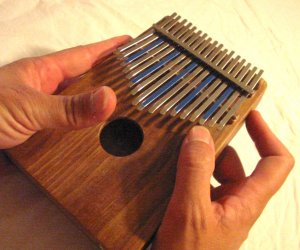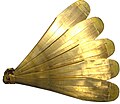
Lamellophone
A lamellophone (also lamellaphone or linguaphone) is a member of the family of musical instruments that makes its sound by a thin vibrating plate called a lamella or tongue, which is fixed at one end and has the other end free. When the musician depresses the free end of a plate with a finger or fingernail, and then allows the finger to slip off, the released plate vibrates. An instrument may have a single tongue (such as a Jew's harp) or a series of multiple tongues (such as a mbira thumb piano).
Linguaphone comes from the Latin root lingua meaning "tongue", (i.e., a long thin plate that is fixed only at one end). lamellophone comes from the Latin word lamella for "small metal plate",[1] and the Greek word φωνή phonē for "sound, voice".[2]
The lamellophones constitute category 12 in the Hornbostel–Sachs system for classifying musical instruments, plucked idiophones. There are two main categories of plucked idiophones, those that are in the form of a frame (121) and those that are in the form of a comb (122).
According to Sachs,[3]
Schaeffner's musical instrument classification scheme has a post-prominent place for the linguaphones (lamellophones) at the second highest level of classification.
In 1932, Andre Schaeffner developed a new classification scheme that was "exhaustive, potentially covering all real and conceivable instruments" [Kartomi, p. 176].
Schaeffner's system has only two top-level categories denoted by Roman numerals (Schaeffner, A.: Origine des instruments de musique, pp. 371–377.):

